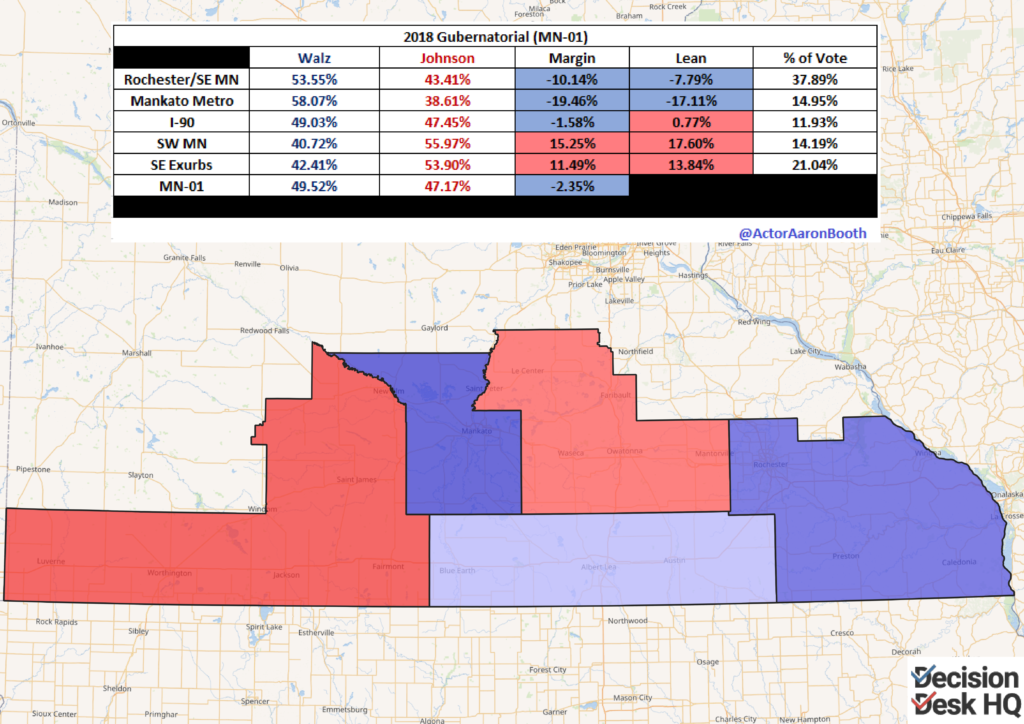Minnesota’s First Congressional district was one of two in Minnesota that flipped from blue to red in 2018. GOP Congressman Jim Hagedorn has just come off two consecutive losses to Tim Walz, but with Walz running for Governor he saw an opening for the third time to really be the charm. While the district was particularly friendly to Donald Trump in 2016, Biden seems poised to close that gap in 2020. With a well-funded opponent in Dan Feehan, Hagedorn’s reelection already seemed to be somewhat competitive. Hagedorn, however has now had multiple scandals that are at the very least not helping.
First there was the constituent mail scandal involving contracts being directed to companies with contacts to Hagedorn’s office. Second there was recently a revelation that Hagedorn’s office emailed the national park service to get his wife a free guided tour of the Grand Canyon. Third, has been the issue of residency. While members of Congress are not required to reside in the district that they represent, there have been questions about Hagedorn’s residency. Hagedorn is registered to vote in Blue Earth which is in Faribault County. His spouse, Minnesota GOP Chair Jennifer Carnahan is registered to vote in St. Louis Park which is in Hennepin County within the 3rd Congressional district. Most recently, after being exposed to the president who was later diagnosed with COVID-19, Hagedorn and two other Minnesota Republican members of Congress traveled on a Delta flight. While no single one of these developments would be enough sink a candidacy in our fast paced news cycle, the combination of the four and Biden likely over-performing Clinton by a notable margin, may be too high of a mountain for Hagedorn.




For the purposes of demonstration, I have broken down the district into five regions. The two keys for a DFL’er are the Mankato metro area (containing Blue Earth and Nicollet counties) and the Rochester area (containing Olmsted, Winona, Fillmore and Houston counties). These are the two largest population centers in the district and are therefore what can be considered the Democratic base. Olmsted containing the growing city of Rochester and the Mayo Clinic has become more and more like the Twin Cities metro with growing number of college educated affluent white voters. The Mankato metro area has a history of being more blue for longer than the Rochester area. The Mankato area is also where Tim Walz and Dan Feehan are from and therefore their performances there may be a bit candidate specific.
The GOP base is the rural southwestern part of the district as well as slice of the district in between Mankato and Rochester. The goal for Hagedorn is to run up the score in these places which will account for a little over a third of the vote. Hagedorn running ahead of Jeff Johnson’s margin
The “swing” region that will likely decide the race is the I-90 corridor encompassing Faribault, Freeborn and Mower counties. Up until recently, this was a strong region for the DFL between Albert Lea and Austin. Walz was able to carry the district in 2016 and 2018 in large part due to edging out Hagedorn and Johnson in this region. Had Feehan performed as Walz did in the area, he very well may have held the seat for the DFL in 2018. Clinton’s 16-point loss in the region in 2016 was emblematic of her overall performance with rural and small town electorates across the nation. Joe Biden’s apparent polling strength among white non college educated voters and senior citizens would suggest he will over-perform Clinton here and that is something Feehan would benefit from.
With redistricting looming and the uncertainty over how many districts the state will have, the district will likely look quite different by the time 2022 rolls around. If the DFL is able to flip the state Senate and get trifecta control over the process, the district may shed portions of the district west of Mankato as well as include Northfield and Red Wing which are currently in the 2nd district.
Aaron Booth (@ActorAaronBooth) is a contributor to Decision Desk HQ.